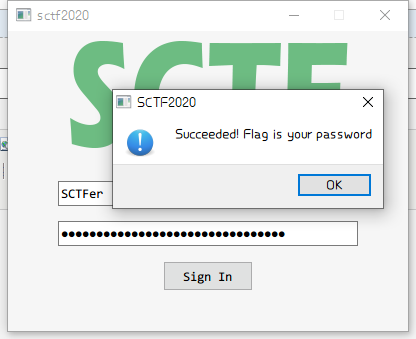简介
Pyhton是一个脚本语言,在运行Python代码时,最终由Python解释器来执行。解释器就是Python的运行环境,但是除了开发人员,大部分人在使用时并不会安装Python。所以官方就提供了一些打包程序,将代码与解释环境打包到二进制文件中,方便在各种操作系统中运行。
下面为一些文件格式:
- .py: Python代码文件。对于一些开源项目,发布方也许会直接提供源码,但是使用时需要安装依赖库
- .pyc: 源码编译后的中间式文件,其目的是为了加快下次运行时的速度。不能直接运行,需要python虚拟机的支持才可以运行,类似于java、.net平台的中的虚拟机,因此可以pyc文件可以跨平台执行。不同的python编译出的pyc文件是不同的,例如python2.4编译出的pyc文件,2.5不可以使用
- 可执行文件:针对得专业人员,直接提供可执行文件,只需要了解使用方法即可,缺点是可移植性差,需要针对不同的操作系统,生成可执行文件。
下面是一些打包为可执行文件的方法:

下面的实验,我主要使用pyinstaller打包文件。
Python文件打包
配置说明
下载方法:
pip install pyinstaller
或者使用打包好的包,访问:http://www.pyinstaller.org/downloads.html 下载对应平台的压缩文件,解压后打开解压路径,执行
python setup.py install
验证
pyinstaller -v

参数
-F 制作独立的可执行程序
-D 制作出的档案存放在同一个文件夹下(默认值)
-K 包含TCL/TK(对于使用了TK的,最好加上这个选项,否则在未安装TK的电脑上无法运行)
-w 制作窗口程序
-c 制作命令行程序(默认)
-X 制作使用UPX压缩过的可执行程序(推荐使用这个选项,需要下载UPX包,解压后upx.exe放在Python(非PyInstaller)安装目录下,下载upx308w.zip)
-o DIR 指定输出SPEC文件路径(这也决定了最后输出的exe文件路径)
--icon=[ICO文件路径] 指定程序图标
-v [指定文件] 指定程序版本信息
-n [指定程序名] 指定程序名称
Windows:生成exe文件
正常使用
pyinstaller -F test.py
可执行文件存储在dist/test文件夹中,不过我这环境出了点问题,使用
pyinstaller -D test.py

进入build/test文件夹,将Python环境安装处的Python37.dll拷贝到目录,再执行该目录下的test.exe

Linux:生成ELF
下载方法和windows平台相同。

打包生成ELF
pyinstaller -F test.py

pyinstaller打包程序识别
exe图标特征

exe字符串特征

和Python语句很类似__file__,__main___,此外也有很多Python的特征

ELF字符串特征

ELF主函数特征
在Linux上运行pyintaller打包的可执行文件时,它会将打包好的文件解压到临时文件夹(/tmp)中的_MEIxxxxxx 路径中暂时存放,执行完毕之后再删除。所以在主函数起始位置会有如下特征
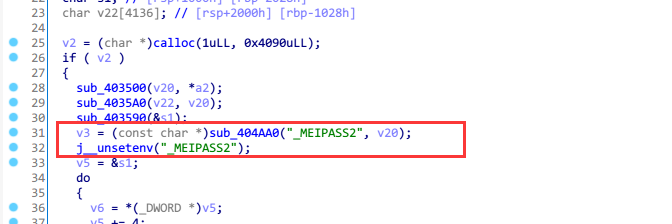
反编译文件
我们要将Python打包成的可执行文件,首先要利用archive_viewer.py将exe/elf反编译为pyc字节码,再使用uncompyle6反编译为py文件。
反编译为pyc文件
archive_viewer.py就在我们的pyinstaller安装包文件夹中。例如我的Python环境中:
Win:D:AnacondaLibsite-packagesPyInstallerutilscliutils
Linux:/home/ubuntu/.local/lib/python3.6/site-packages/PyInstaller/utils/cliutils
参数
U: go Up one level
O <name>: open embedded archive name
X <name>: extract name
Q: quit
首先,我们要解析EXE/ELF文件数据包,将可执行文件放置到与archive_viewer.py同目录下,使用命令:
python archive_viewer.py test.py

有很重要的两点:
- 反编译EXE/ELF文件的Python版本必须与打包时的版本一致
- 反编译的pyc文件命名必须遵照上面红框中的“test”
其次,提取test.pyc和struct.pyc文件(后面会说明该文件作用)
? x test
to filename? test.pyc
? x struct
to filename? struct.pyc

Linux端相同

下面Win和Linux端操作相同,只讲述Win端。
文件修补
使用pyinstaller打包的文件,文件头的数据会被抹消掉。再还原的过程中,我们需要手动进行修补。文件头的格式为:magic(4字节,编译器标志) + 时间戳(4字节)。在实际修补时,需要添加的数据可能不止是8个字节。
将test.pyc和struct.pyc对比

struct.pyc比test.pyc多出16字节,将这16字节插入test.pyc的头部

反编译字节码文件
这里需要使用到uncompyle6(如果是Python2.7需要使用uncompyle2)
安装
pip install uncompyle6
或者
git clone https://github.com/rocky/python-uncompyle6.git cd python-uncompyle6 python setup.py install
反编译
uncompyle6 test.pyc > test.py

实战演练
准备
signin.exe:

我们的目标是获取程序登录的账户密码。
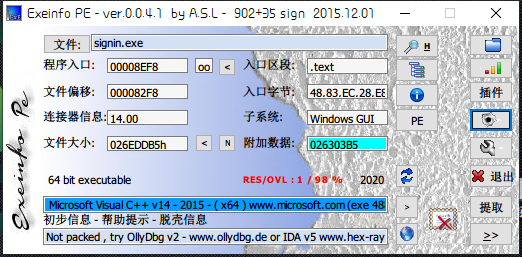
未加壳的64位可执行文件。
程序分析
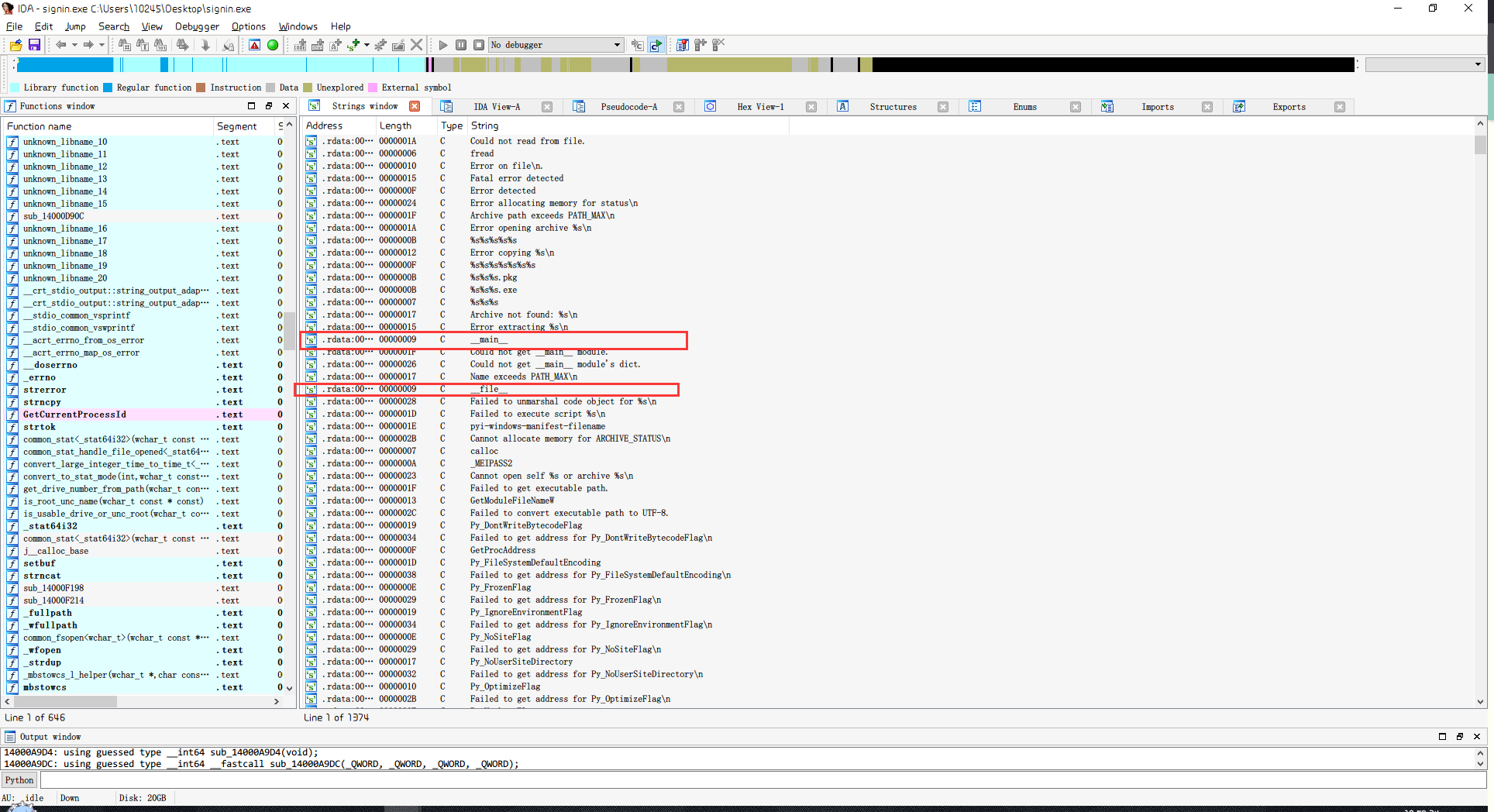
可以判断出,这个程序实际上是由Python打包成的可执行文件,且在运行这个程序时,在同目录下产生了一个tmp.dll文件,猜测是程序调用某些函数的接口。
反编译
使用archive_viewer.py反编译为字节码文件
python archive_viewer.py signin.exe
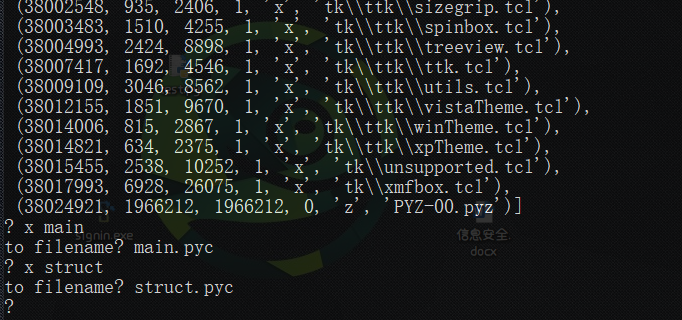
修补文件

55 0D 0D 0A 00 00 00 00 70 79 69 30 10 01 00 00

程序是在Python3.8环境下打包,因此我们需要在Python3.8下使用uncompyle6
uncompyle6 main.pyc > main.py
得到py文件
1 # uncompyle6 version 3.7.2 2 # Python bytecode 3.8 (3413) 3 # Decompiled from: Python 3.8.0 (tags/v3.8.0:fa919fd, Oct 14 2019, 19:37:50) [MSC v.1916 64 bit (AMD64)] 4 # Embedded file name: main.py 5 # Compiled at: 1995-09-28 00:18:56 6 # Size of source mod 2**32: 272 bytes 7 import sys 8 from PyQt5.QtCore import * 9 from PyQt5.QtWidgets import * 10 from signin import * 11 from mydata import strBase64 12 from ctypes import * 13 import _ctypes 14 from base64 import b64decode 15 import os 16 17 class AccountChecker: 18 19 def __init__(self): 20 self.dllname = './tmp.dll' 21 self.dll = self._AccountChecker__release_dll() 22 self.enc = self.dll.enc 23 self.enc.argtypes = (c_char_p, c_char_p, c_char_p, c_int) 24 self.enc.restype = c_int 25 self.accounts = {b'SCTFer': b64decode(b'PLHCu+fujfZmMOMLGHCyWWOq5H5HDN2R5nHnlV30Q0EA')} 26 self.try_times = 0 27 28 def __release_dll(self): 29 with open(self.dllname, 'wb') as (f): 30 f.write(b64decode(strBase64.encode('ascii'))) 31 return WinDLL(self.dllname) 32 33 def clean(self): 34 _ctypes.FreeLibrary(self.dll._handle) 35 if os.path.exists(self.dllname): 36 os.remove(self.dllname) 37 38 def _error(self, error_code): 39 errormsg = {0:'Unknown Error', 40 1:'Memory Error'} 41 QMessageBox.information(None, 'Error', errormsg[error_code], QMessageBox.Abort, QMessageBox.Abort) 42 sys.exit(1) 43 44 def __safe(self, username: bytes, password: bytes): 45 pwd_safe = b'x00x00x00x00x00x00x00x00x00x00x00x00x00x00x00x00x00x00x00x00x00x00x00x00x00x00x00x00x00x00x00x00x00' 46 status = self.enc(username, password, pwd_safe, len(pwd_safe)) 47 return (pwd_safe, status) 48 49 def check(self, username, password): 50 self.try_times += 1 51 if username not in self.accounts: 52 return False 53 encrypted_pwd, status = self._AccountChecker__safe(username, password) 54 if status == 1: 55 self._AccountChecker__error(1) 56 if encrypted_pwd != self.accounts[username]: 57 return False 58 self.try_times -= 1 59 return True 60 61 62 class SignInWnd(QMainWindow, Ui_QWidget): 63 64 def __init__(self, checker, parent=None): 65 super().__init__(parent) 66 self.checker = checker 67 self.setupUi(self) 68 self.PB_signin.clicked.connect(self.on_confirm_button_clicked) 69 70 @pyqtSlot() 71 def on_confirm_button_clicked(self): 72 username = bytes((self.LE_usrname.text()), encoding='ascii') 73 password = bytes((self.LE_pwd.text()), encoding='ascii') 74 if username == b'' or password == b'': 75 self.check_input_msgbox() 76 else: 77 self.msgbox(self.checker.check(username, password)) 78 79 def check_input_msgbox(self): 80 QMessageBox.information(None, 'Error', 'Check Your Input!', QMessageBox.Ok, QMessageBox.Ok) 81 82 def msgbox(self, status): 83 msg_ex = {0:'', 84 1:'', 85 2:"It's no big deal, try again!", 86 3:'Useful information is in the binary, guess what?'} 87 msg = 'Succeeded! Flag is your password' if status else 'Failed to sign in ' + msg_ex[(self.checker.try_times % 4)] 88 QMessageBox.information(None, 'SCTF2020', msg, QMessageBox.Ok, QMessageBox.Ok) 89 90 91 if __name__ == '__main__': 92 app = QApplication(sys.argv) 93 checker = AccountChecker() 94 sign_in_wnd = SignInWnd(checker) 95 sign_in_wnd.show() 96 app.exec() 97 checker.clean() 98 sys.exit() 99 # okay decompiling main.pyc
代码分析
通过代码我们能够了解到这些信息
1.
elf.dllname = './tmp.dll'
调用了tmp.dll文件作为接口。
2.
def __safe(self, username: bytes, password: bytes): pwd_safe = b'x00x00x00x00x00x00x00x00x00x00x00x00x00x00x00x00x00x00x00x00x00x00x00x00x00x00x00x00x00x00x00x00x00' status = self.enc(username, password, pwd_safe, len(pwd_safe)) return (pwd_safe, status) def check(self, username, password): self.try_times += 1 if username not in self.accounts: return False encrypted_pwd, status = self._AccountChecker__safe(username, password) if status == 1: self._AccountChecker__error(1) if encrypted_pwd != self.accounts[username]: return False self.try_times -= 1 return True
self.accounts = {b'SCTFer': b64decode(b'PLHCu+fujfZmMOMLGHCyWWOq5H5HDN2R5nHnlV30Q0EA')}
调用tmp.dll文件中的enc函数,传入username, password, pwd_safe, len(pwd_safe),实际就是将password加密后存储到pwd_safe字节码中。最后用pwd_safe与b64decode(b'PLHCu+fujfZmMOMLGHCyWWOq5H5HDN2R5nHnlV30Q0EA')比较,且我们能够了解到用户名应该是SCTFer,且最后返回的status一个为非1。
打开tmp.dll文件,找到enc函数

观察代码,实际操作可以分为两部分,逆向分析
异或操作
第47~54行代码实际上就是将Dst与用户名循环异或,最后得到b64decode(b'PLHCu+fujfZmMOMLGHCyWWOq5H5HDN2R5nHnlV30Q0EA'),因此我们只需要逆向异或就能得到加密后的Dst
from base64 import * username = "SCTFer" pwd_safe = b64decode('PLHCu+fujfZmMOMLGHCyWWOq5H5HDN2R5nHnlV30Q0EA') # print (len(pwd_safe)) num = ["%02x" % x for x in pwd_safe] hex_num = [int(x, 16) for x in num] print(num) # print (len(num)) for i in range(32): hex_num[i] ^= ord(username[i % len(username)]) # print (hex_num) hex_nums = bytes.fromhex(''.join([hex(x)[2:].rjust(2, '0') for x in hex_num])) print (hex_nums)
得到
b'oxf2x96xfdx82x9cxdexb52vx86yK3xe6x1fx06xd8xb7=x13Jxb8xe3xb52xb3xd38x86x10x02x00'
加密操作
每次传入了8字节数据进行加密(总共64字节),打开sub_180011311函数
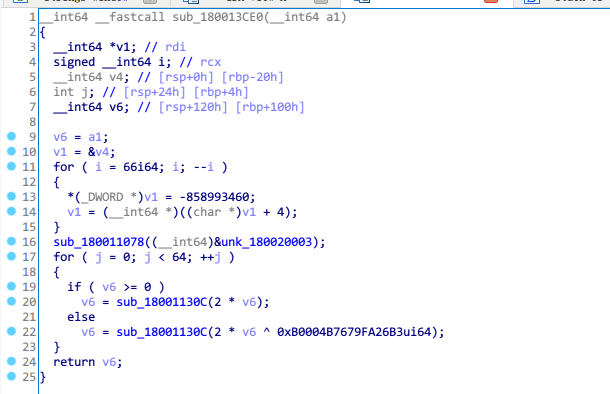
仔细观察代码,实际上这部分代码是使用CRC32的查表法,对数据进行加密。
加密原理实际上就是CRC32算法---输入一组长度48的字符串,每8个字节分为1组,共6组。对每一组取首位,判断正负。正值,左移一位;负值,左移一位,再异或0xB0004B7679FA26B3。重复判断操作64次,得到查表法所用的表。
因此我们只需要将整个加密过程逆向操作得到查表法的表,再进行CRC64计算,就能得到输入。
secret = [] # for i in range(4): # secret.append(int(hex_nums[i*8:(i + 1) * 8][::-1].hex(),16)) for i in range(4): secret.append(int.from_bytes(hex_nums[i*8:(i + 1) * 8], byteorder="little")) print (secret) key = 0xB0004B7679FA26B3 flag = "" for s in secret: for i in range(64): sign = s & 1 if sign == 1: s ^= key s //= 2 if sign == 1: s |= 0x8000000000000000 print(hex(s)) j = 0 while j < 8: flag += chr(s&0xFF) s >>= 8 j += 1 print(flag)
因为计算机中采用小端排序,因此需要注意分组倒序。得到

脚本
from base64 import * username = "SCTFer" pwd_safe = b64decode('PLHCu+fujfZmMOMLGHCyWWOq5H5HDN2R5nHnlV30Q0EA') # print (len(pwd_safe)) num = ["%02x" % x for x in pwd_safe] hex_num = [int(x, 16) for x in num] print(num) # print (len(num)) for i in range(32): hex_num[i] ^= ord(username[i % len(username)]) # print (hex_num) hex_nums = bytes.fromhex(''.join([hex(x)[2:].rjust(2, '0') for x in hex_num])) print (hex_nums) secret = [] # for i in range(4): # secret.append(int(hex_nums[i*8:(i + 1) * 8][::-1].hex(),16)) for i in range(4): secret.append(int.from_bytes(hex_nums[i*8:(i + 1) * 8], byteorder="little")) print (secret) key = 0xB0004B7679FA26B3 flag = "" for s in secret: for i in range(64): sign = s & 1 if sign == 1: s ^= key s //= 2 if sign == 1: s |= 0x8000000000000000 print(hex(s)) j = 0 while j < 8: flag += chr(s&0xFF) s >>= 8 j += 1 print(flag)
账户密码
username:SCTFer
password:SCTF{We1c0m3_To_Sctf_2020_re_!!}
